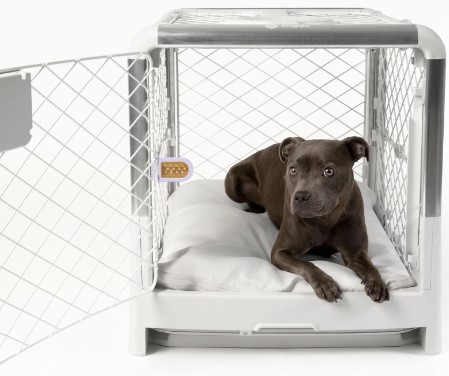Do you know that external house doors and windows are two of the top 10 reasons that dogs get lost1? If they have the chance, many dogs and cats will take an open door or window as a chance to explore. Even if they love you and your treats and toys, they will still want to go explore.
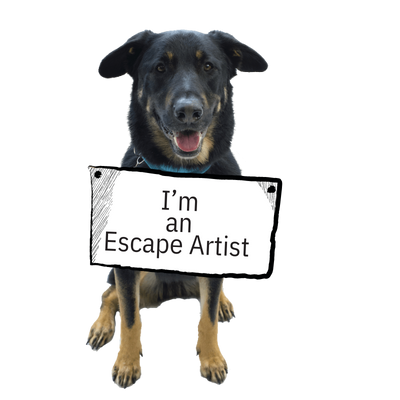
If you have an escape artist kitty or doggo or even just a curious dog or cat, Houdini-proofing your house is essential to keep them safe and sound. With some simple steps, you can make sure there are no gaps for your furry friend to run away.
Before you read more, remember this key thing about preventing lost pets: A collar tag and microchip are critical.
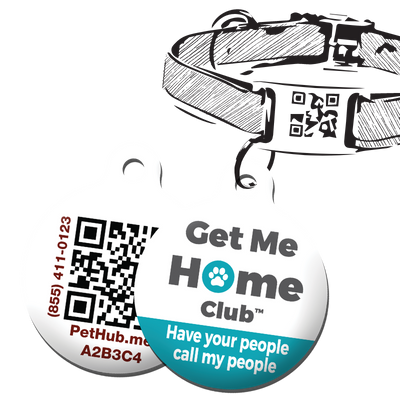
You should never rely solely on a microchip. However, your dog or cat should definitely have one. It's simply the ultimate safety net. Make sure it's not only registered but also up-to-date with correct information. Many dogs and cats in shelters have microchips, but the contact information linked to them is not correct. This makes it hard for people to find the pet's owner.
Never let your pet be home alone, walking around naked. It's just dangerous. An external ID tag is simply the fastest way to get them home. To give the best protection, use PetHub-powered digital IDs.
Now, if they are in a crate all day, it is safest to remove their collar while crated (but put that sucker right back on as soon as you "release the hound").
Now let's get down to the big reason you're here. You have a "flight risk" fur kid and you need to button up the escape route paw-sibilities. We've covered all the bases, and even have some product ideas below to help you build your own "Furry Fort Knox."
Physical Ways to Keep Your Cat or Dog Indoors
Keep Doors and Windows Closed
One of the best ways to prevent a dog or cat from escaping is to keep doors and windows closed. This will help to keep them from getting out, and will also help to keep other animals from getting in. If you have a screen door, make sure it is tightly shut so your pet can't open it.

Some dogs and cats are super smart and have figured out how to open a closed door (sneaky!). If your pet is very clever, you may need to buy some special door safety products. These products can keep even the smartest pets from opening a door. (No promises, though, if your fur kid is wicked smart.)
Door Handle Safety Products
PetHub team members use these childproof latches in our own homes for both toddlers AND fur kids!
Use Caution with Open Windows
If you choose to keep windows open in your home, use caution to prevent your pet from escaping. For example, only open windows that are high off the ground and not easily accessible. Realize, however, that most cats and many dogs can leap to high places, so even a high window may not be safe.

Alternatively, you can improve window pet-proofing by installing stronger screens. This will hopefully keep them from getting out while still allowing fresh air into the home. Still, cats can scratch and claw, and dogs can chew or charge their way through a standard window or door screen if unattended and they are in a determined frame of mind or scared.
Window Protection Products to Explore
- MAGZO Pet Proof Window Screen Replacement
- WAOWAO Window Safety Guards
- Reinforced Cat Screen Door
- Lock-it Block-it Window & Sliding Door Bar
Create a Safe Space
Designate a room in your home as a “safe room” or enclosed space for your dog or cat. This should be a quiet space where they can go to relax and feel safe, with a door or gate that is secure, complete with fresh water and food, and a cat or dog bed so they have a comfy place to sleep.
Many pet parents use crates while they are away from home, and crate training is a proven successful safety measure. Fill the space with their favorite toys (even crated pets wanna have fun!) and bedding, and make sure it’s free of anything that could hurt them (e.g., electrical cords).
Another trick, especially for those pets that have a fear of loud noises, is to have a calming sound machine or loud fan in the enclosed area. This will help drown out any sudden or loud noise outside that may scare them and trigger a panicked flight response.
PetHub Team's Favorite Crate Options
Diggs Revol Crates
Frisco & Unipaws Furniture Style Crates
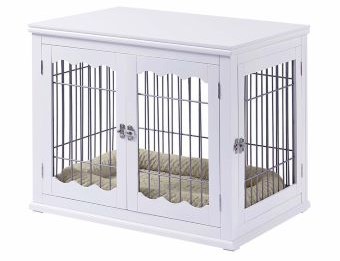
Explore Furniture Style Crates on Chewy
Use Portable Gates
Baby gates can be used to create boundaries in a doorway area or hall. They can prevent pets from getting into areas of the home where they could get lost or hurt (e.g., the kitchen). It may also be helpful to place a gate in the entryway that leads to your front door. Dogs in particular love to greet new guests. A baby gate allows them to see visitors but prevents door dashing.
Make sure the gate is tall enough and sturdy enough that your dog or cat cannot hop over it or push it down. Know that gate won't deter most cats and even some high-jumper dogs.
Some gates even have separate openings that act as cat doors. This is very helpful if you have a doggo you need to secure, but your cat needs to have clear access through the doorway.
Chewy has an incredible selection of gates, pens and indoor fence options.

Outside Access for Potty Time
Many homes have a special cat door or doggy door built into the back door or near it. It is very helpful for busy families and it helps keep the inside of the house clean. But, it can be dangerous too. A "smart" door like Pet Safe's Connected Smart Door. can help make sure only your pet can go in and out of the house. It can also lock the door when you are not at home so your pet stays inside. You can control this with an app on your phone or tablet.
Door Opening Alarms
Door sensor alarms are another effective tool to try. These devices, typically installed on doors or entryways, emit a loud sound or notification when the door is opened, alerting pet owners to their furry friend's attempt at escape.
Outdoor Cameras
If your pet does sneak out to explore the great outdoors, having outdoor cameras can help you locate them more quickly. Brands like Ring, in fact, have proven to be a very helpful tool in searching for a lost pet. They can also help you understand what kind of situation lead to the escape and help you pet-proof things better.
Behavior Issues to Address
Keep Them Entertained
If you want to keep your cat or dog safe, make sure they have fun things to do. Pets that are bored may try to escape. Give them lots of toys and playtime so that they do not get bored and try to get away when you are gone. Puzzle toys are a great option!
Our Favorite "Home Alone" Safe Boredom Busters
Know Where Your Pet Is at All Times
Another way to Houdini-proof your space is to make sure that you always know where your animals are located within it. This means keeping track of them when they are inside as well as when they are outside or on a walk. If you have multiple furry family members, consider keeping them in separate rooms or areas of the house so that you can easily keep track of where each one is located.

Train Regularly
It is important to practice training with your dog or cat. This will help them stay safe and not run away. Basic commands like "sit," "stay," and "come" can help you control them whether they're inside or outside. Training also strengthens the bond between you and your pet.
Practicing these skills weekly will help your pet feel safest and most secure when near you. A well-trained pet is less likely to run away from you for fun. Crate training can help your pet learn that it is safe inside its crate. This will also keep them from getting too anxious when it is alone.
PetHub Staff Picks for Dog Training Resources
- Good Pup
- Zuke's Mini Naturals Training Treats
- Article: 7 Commands to Keep Your Pet Safe
- Podcast: Science of Dog Training
Identify Favorite Hiding Spots

If you have a fur kid that just loves to be alone and hide from the chaos, make sure you're keeping track of their favorite hidey holes (usually small spaces that allow them to watch you in secret). Take 10 minutes to closely inspect each of their known haunts. Particularly for cats and small dogs, hiding is a more common "lost pet" scenario than you may imagine.
Other Safety Measures
Keep Nails Trimmed
Another way to Houdini-proof your home is to keep your critter's nails trimmed. Claws can be used to snag and tear window screens. Just the smallest opening is often enough for a determined cat. They will work at the torn screen to make a big enough hole to wiggle out and go bird hunting. We recommend the Zen Clipper for a stress-free nail trimming session.
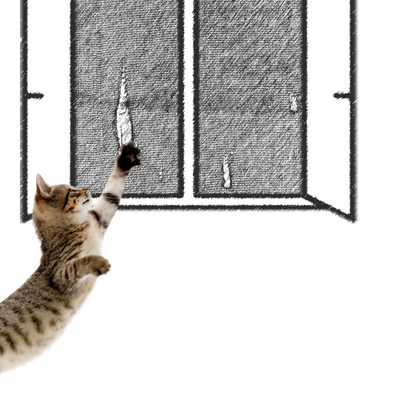
Spay or Neuter
Getting your cat or dog spayed or neutered is important. Unaltered animals have a strong instinct to find a mate outside the house. Male cats and dogs want to find lots of girlfriends, which can cause more unwanted pets in shelters. Spaying or neutering reduces this desire, which makes your pet calmer and less likely to try to escape.
Notify Guests
It can be as simple as a sign saying "Watch for the Sneaky Cat!" or "Please Close Gate So Dog Can't Escape." You can make your own. OR, if you want to be super duper fun and fancy, check out custom signs on Etsy.
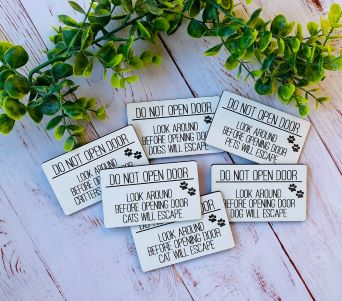
Have an "Exit" Routine
Before you leave your house, make sure to always do the same thing with your pet. Routines help both you and the pet feel safe and secure. For fur kids that have free roam of rooms, make sure you "have eyes on" them before you close the door and lock your home.
One trick is to play a quick game of fetch or give "everyone" a treat before you leave. The treat should be something safe for them to eat quickly so you don't risk a choking hazard while you are away.
Plan Transitions for Going Outside
One of the most important times when you can prevent your pet from escaping is when you are taking them outside (other than into a fenced and secure yard). You never know when an unexpected squirrel chase or scary sound will convince your dog they need to bolt. Whenever you are going on a car trip with your pet, here are some things you should always do:
- Have them secured in their travel crate or on a leash before you open the door, and your hand firmly around the handle
- If using a leash, we recommend investing in a leash that not only has a hand-hold but also secures your body
- Focus just on getting them to the car and buckling them inside (don't try to juggle a bunch of other bags or tasks at the same time)
- If you are using public transit, use a backpack so you can be completely "hand-free" and have both hands available for critter management
- Don't open the travel crate or release the leash until you are safely inside and secured at your new destination
When to Consider a Dog Walker or Day Care
Do you leave for long times during the day? Does your pet like to have company and always want something to do? If your dog keeps running away from home, it might be a good idea to get a dog walker or take your dog to doggy daycare while you are away.
Services like Rover and Wag can help you find a local dog walking service that can come in a time or two every day to keep your dog calm by giving them daily walks while you are at work. Doggy daycares have safe places for dogs to play with other dogs. They often even have a special area outside that is secure and fenced. The dogs can go out and feel the sun on their fur.
Double Check Your Work
Before you walk away from your pet's safe space, crate or enclosure, ask yourself: Can they escape this? You might be shocked.
My cat taught me that he actually CAN get the door open from the room we shut him in. He just usually chooses not to and let me know that one morning after I thought he was securely in a closed room. Nice.
Our CTO's dog was always "safely" behind a baby gate at the office so he wouldn't bolt out when the lobby door opened. One afternoon, we all watched in shock as he casually jumped the gate, went to the kitchen for a drink and then casually hopped back over the gate and into his space. Yikes!
Before we finish, one more thing: We at PetHub recommend that you always keep your dog inside when you are not with them. We also think cats should stay inside all the time, unless on a leash and cat harness.
We understand that sometimes it is impossible to keep your pet inside. But if you do, it will help keep them safer. They won't get lost, stolen, or hurt by other animals.
Check out our matching infographic with 10 of the most important tips to keep your pet safe from this article!
(1) According to the 2022 National Return-to-Home Study by the National Animal Care and Control Association and PetHub, Inc.



